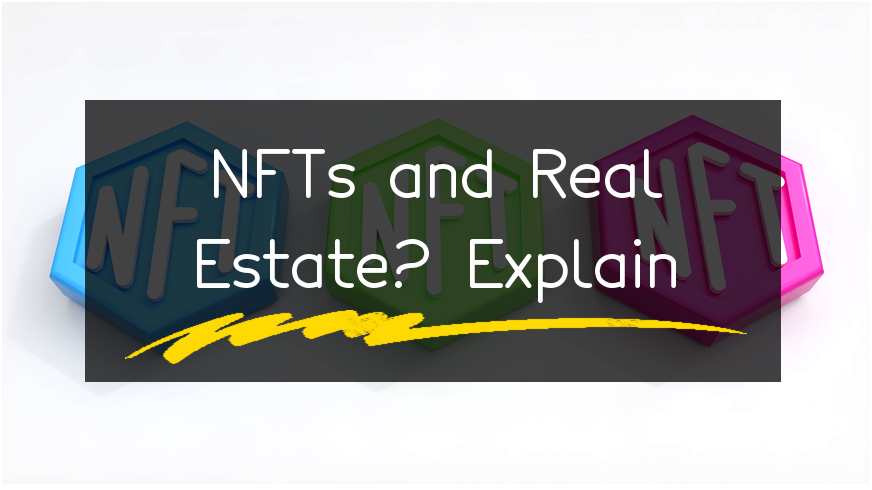NFTs (Non-Fungible Tokens) are digital tokens that represent ownership or proof of authenticity of a digital asset, such as artwork, music, videos, and even tweets. NFTs are unique and verifiable, which means that they cannot be replicated or duplicated, and their authenticity can be verified on the blockchain.
In the real estate industry, NFTs can be used to represent ownership or proof of authenticity of real estate assets. For example, an NFT can be used to represent ownership of a piece of land or a building, or to verify the authenticity of a property title or a lease agreement.
NFTs can also be used in the buying and selling of real estate assets, offering a more streamlined and secure process. They can be used to create digital contracts and smart contracts that automate the process of transferring ownership and payment.
Additionally, NFTs can be used to fractionalize real estate assets, allowing multiple investors to own a piece of a property, rather than an entire property. This can make real estate investments more accessible and affordable to a wider range of investors.
Overall, NFTs have the potential to transform the way real estate transactions are conducted, making them more secure, efficient, and accessible.
What Are NFTs?
An NFT (Non-Fungible Token) is a digital asset that represents ownership of a unique item or piece of content on a blockchain network. Think of it as a digital record of ownership, like a digital certificate of authenticity. NFTs can be used to represent a wide range of digital assets such as artwork, music, videos, and even tweets. Because they are unique and cannot be replicated, NFTs have become particularly popular in the art world, where they allow artists to monetize their digital artwork and collectors to own unique digital pieces. NFTs have gained widespread attention recently due to high-profile sales of digital artwork and collectibles, such as the $69 million sale of a digital artwork by Beeple.
Bored Apes & Coolheadz
Bored Apes and Coolheadz are two different NFT collections that have gained popularity recently.
Bored Apes is an NFT collection of 10,000 unique cartoon-style ape illustrations, each with its own personality and traits. These apes have become a popular status symbol within the crypto community, with some selling for millions of dollars. Each Bored Ape owner also gains access to a members-only online community, where they can connect and network with other owners.
Coolheadz, on the other hand, is a collection of 6,669 unique hand-drawn illustrations of various cool and lively characters. These NFTs were designed to showcase the creative talent of a group of artists from around the world. Coolheadz are not as valuable as Bored Apes, but they are also becoming popular among collectors.
Both Bored Apes and Coolheadz are part of the larger NFT craze, which is rapidly growing and changing the way we think about art and ownership in the digital age.
Blockchain Technology Underlying NFTs
Blockchain technology is the underlying technology behind NFTs that enables the creation of unique digital assets that cannot be replicated or counterfeited.
At its core, a blockchain is a decentralized digital ledger that is maintained by a network of users. It is a distributed ledger technology that consists of a series of blocks, each containing a list of transactions. Each block is connected to the preceding block, creating a chain of blocks, hence the name "blockchain".
One of the key features of blockchain technology is its ability to create a transparent and secure system that ensures the authenticity and immutability of digital assets. This is achieved through cryptographic algorithms, which create a secure and tamper-proof system.
NFTs (non-fungible tokens) are unique digital assets that are created using blockchain technology. These tokens are digitally verified and stored on a blockchain, making them tamper-proof and resistant to duplication or counterfeiting.
The unique aspects of NFTs are possible because of the blockchain's decentralized and immutable nature. The blockchain technology used in NFTs ensures that each token is associated with a unique digital signature, which makes it impossible for the token to be duplicated or counterfeited.
In summary, the blockchain technology underlying NFTs is a decentralized and tamper-proof system that ensures the uniqueness and authenticity of digital assets by using cryptographic algorithms to create a secure and transparent ledger.
From Old School to Online Marketplaces
NFTs (non-fungible tokens) have been around since the early days of blockchain technology, but they were mostly used in niche areas such as online gaming or cryptocurrency exchanges. However, with the rise of blockchain-based art and collectibles in recent years, NFTs have gained mainstream attention, with online marketplaces like OpenSea, Rarible, and SuperRare popping up to facilitate their sale.
One reason for the popularity of NFTs is their unique ownership verification system, which allows buyers to prove that they own a piece of digital art or collectible. This feature is particularly valuable for artists and creators, who can sell their works directly to fans without worrying about piracy or copyright infringement.
Another factor in the rise of NFTs is the growing interest in blockchain technology and cryptocurrency. As more people become familiar with these concepts, they are seeking out new ways to invest, collect, and trade digital assets. NFTs offer a way to leverage this interest, allowing buyers to own unique, one-of-a-kind items that are not easily replicated or duplicated.
Finally, the pandemic has also played a role in the rise of NFTs. With traditional art galleries and auction houses closed due to lockdowns and social distancing, artists and collectors have turned to online marketplaces to connect and transact. NFTs have become a popular way to buy and sell digital art, collectibles, and other assets in this new online world.
Overall, NFTs have gone from a niche technology to a mainstream phenomenon, thanks to factors such as unique ownership verification, growing interest in blockchain and cryptocurrency, and the impact of the pandemic. As more people discover the benefits of NFTs, it is likely that we will see even more innovation and adoption in the years to come.
NFTs and Real Estate
NFTs (Non-Fungible Tokens) are digital assets that represent ownership of unique items such as artworks, music, collectibles, or in this case, real estate properties. In the world of real estate, NFTs can be used to represent ownership of properties, allowing buyers to own a fractional ownership of a specific property without having to buy the entire property.
For example, let's say a property owner wants to sell a luxury apartment worth $10 million. Using NFTs, the property can be divided into a predefined number of tokens with each token representing a certain percentage of ownership. The tokens can then be sold to multiple buyers, allowing them to own a portion of the property. These owners can benefit from rental income, appreciation in value, and capital gains when the property is sold.
NFTs can also provide greater liquidity for the real estate market, enabling investors to buy and sell their fractional ownership with ease. Additionally, using NFTs can reduce the need for intermediaries like brokers or agents, making real estate transactions more efficient.
Overall, NFTs are a new and innovative way to invest in real estate that provides fractional ownership, liquidity, and transparency to property investors.
Just one more thing: if you liked the article, please like us on social media and share this article with friends.



